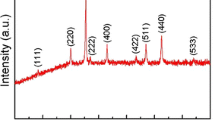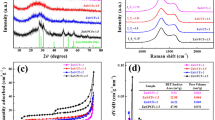Abstract
A simple and novel method that combines the electrospinning technology with nonaqueous sol–gel method is developed to incorporate Fe2O3 nanoparticles into ZIF-8-derived nitrogen-doped highly porous carbon fibers (NPCFs). The size of Fe2O3 nanoparticles is about 5 nm. The interfacial interaction between Fe2O3 and NPCFs is investigated by thermogravimetric analysis, Raman spectrum and X-ray photoelectron energy spectrum. We found that Fe2O3 nanoparticles are anchored strongly in the NPCFs through the Fe–O–C covalent bond. The impact of the Fe2O3 content in the composites on electrochemical performance is also studied. When served as the flexible and free-standing anode of lithium-ion batteries (LIBs), the Fe2O3/NPCFs-66.9% exhibits superior electrochemical performance with the high discharge capacity of 1351 mA h g−1 at 50 mA g−1, remarkable rate capability (337 mA h g−1 even at 5000 mA g−1), and stable cycling performance (1106 mA h g−1 after 100 cycles at 100 mA g−1). The excellent anodic property can be ascribed to the ultra-small size of Fe2O3 nanoparticles, and the one-dimensional (1D) structure combined with the excellent electrical conductivity of NPCFs matrix. Moreover, the robust interfacial interaction Fe–O–C bond can restrain the aggregation of Fe2O3 nanoparticles and accommodate the volume change. This can effectively maintain the integrity of the whole electrode during the long-term cycles. The results show that the composite may be considered as a promising anode material for advanced LIBs.







Similar content being viewed by others
References
Zhang Y, Zhao Y, Ren J, Weng W, Peng H (2016) Advances in wearable fiber-shaped lithium-ion batteries. Adv Mater 28:4524–4531. https://doi.org/10.1002/adma.201503891
Nitta N, Wu F, Lee JT, Yushin G (2015) Li-ion battery materials: present and future. Mater Today 18:252–264. https://doi.org/10.1016/j.mattod.2014.10.040
Larcher D, Tarascon JM (2015) Towards greener and more sustainable batteries for electrical energy storage. Nat Chem 7:19–29. https://doi.org/10.1038/nchem.2085
Ji L, Lin Z, Alcoutlabi M, Zhang X (2011) Recent developments in nanostructured anode materials for rechargeable lithium-ion batteries. Energy Environ Sci 4:2682–2699. https://doi.org/10.1039/c0ee00699h
Ji L, Rao M, Zheng H et al (2011) Graphene oxide as a Sulfur immobilizer in high performance lithium/sulfur cells. J Am Chem Soc 133:18522–18525. https://doi.org/10.1021/ja206955k
Li W, Wu J, Chen Y, Wang X, Zhou R, Chen S, Guo Q, Hou H, Song Y (2015) Hollow Nitrogen-doped Fe3O4/Carbon nanocages with hierarchical porosities as anode materials for lithium-ion batteries. Electrochim Acta 186:50–57. https://doi.org/10.1016/j.electacta.2015.10.134
Keppeler M, Shen N, Nageswaran S, Srinivasan M (2016) Synthesis of α-Fe2O3/Carbon nanocomposites as high capacity electrodes for next generation lithium ion batteries: a review. J Mater Chem A 4:18223–18239. https://doi.org/10.1039/c6ta08456g
Li J, Dahn HM, Krause LJ, Le D-B, Dahn JR (2008) Impact of binder choice on the performance of α-Fe2O3 as a negative electrode. J Electrochem Soc 155:A812–A816. https://doi.org/10.1149/1.2969433
Larcher D, Masquelier C, Bonnin D et al (2003) Effect of particle size on lithium intercalation into α-Fe2O3. J Electrochem Soc 150:A133–A139. https://doi.org/10.1149/1.1528941
Larcher D, Bonnin D, Cortes R, Rivals I, Personnaz L, Tarascon JM (2003) Combined XRD, EXAFS, and Mössbauer studies of the reduction by lithium of α-Fe2O3 with various particle sizes. J Electrochem Soc 150:A1643–A1650. https://doi.org/10.1149/1.1622959
Wang Z, Luan D, Madhavi S, Hu Y, Lou X (2012) Assembling carbon-coated α-Fe2O3hollow nanohorns on the CNT backbone for superior lithium storage capability. Energy Environ Sci 5:5252–5256. https://doi.org/10.1039/c1ee02831f
Luo D, Lin F, Xiao W, Zhu W (2017) Synthesis and electrochemical performance of α-Fe2O3@carbon aerogel composite as an anode material for Li-ion batteries. Ceram Int 43:2051–2056. https://doi.org/10.1016/j.ceramint.2016.10.178
Ji L, Toprakci O, Alcoutlabi M et al (2012) α-Fe2O3 Nanoparticle-loaded carbon nanofibers as stable and high-capacity anodes for rechargeable lithium-ion batteries. ACS Appl Mater Interfaces 4:2672–2679. https://doi.org/10.1021/am300333s
Zhu J, Zhu T, Zhou X et al (2011) Facile synthesis of metal oxide/reduced graphene oxide hybrids with high lithium storage capacity and stable cyclability. Nanoscale 3:1084–1089. https://doi.org/10.1039/c0nr00744g
Liu L, Yang X, Lv C et al (2016) Seaweed-derived route to Fe2O3 hollow nanoparticles/N-doped graphene aerogels with high lithium ion storage performance. ACS Appl Mater Interfaces 8:7047–7053. https://doi.org/10.1021/acsami.5b12427
Xiao W, Wang Z, Guo H et al (2013) Fe2O3 particles enwrapped by graphene with excellent cyclability and rate capability as anode materials for lithium ion batteries. Appl Surf Sci 266:148–154. https://doi.org/10.1016/j.apsusc.2012.11.118
Niu Z, Chen J, Hng HH, Ma J, Chen X (2012) A leavening strategy to prepare reduced graphene oxide foams. Adv Mater 24:4144–4150. https://doi.org/10.1002/adma.201200197
Wang X, Zhang M, Liu E et al (2016) Three-dimensional core-shell Fe2O3 @ carbon/carbon cloth as binder-free anode for the high-performance lithium-ion batteries. Appl Surf Sci 390:350–356. https://doi.org/10.1016/j.apsusc.2016.08.112
Park Y, Oh M, Park JS et al (2015) Electrochemically deposited Fe2O3 nanorods on carbon nanofibers for free-standing anodes of lithium-ion batteries. Carbon 94:9–17. https://doi.org/10.1016/j.carbon.2015.06.031
Zhang H, Zhou L, Noonan O, Martin DJ, Whittaker AK, Yu C (2014) Tailoring the void size of iron oxide@carbon yolk-shell structure for optimized lithium storage. Adv Funct Mater 24:4337–4342. https://doi.org/10.1002/adfm.201400178
Zhu Q, Xu Q (2014) Metal-organic framework composites. Chem Soc Rev 43:5468–5512. https://doi.org/10.1039/c3cs60472a
Sun X, Huang H, Wang C, Liu Y, Bu X (2014) Effective CoxSy HER electrocatalysts fabricated in situ sulfurating of metal-organic framework. ChemElectroChem. 5(23):3639–3644. https://doi.org/10.1002/celc.201801238
Wu J, Song Y, Zhou R, Chen S, Li Z, Hou H, Wang L (2015) Zn–Fe–ZIF-derived porous ZnFe2O4/C@NCNTs nanocomposites as anode for lithium-ion batteries. J Mater Chem A 3:7793–7798. https://doi.org/10.1039/c5ta00805k
Chen Y, Zheng L, Fu Y, Zhou R, Song Y, Chen S (2016) MOF-derived Fe3O4/carbon octahedral nanostructures with enhanced performance as anode materials for lithium-ion batteries. RSC Adv 6:85917–85923. https://doi.org/10.1039/c6ra19041c
Kong L, Zhu J, Shuang W, Bu X (2018) Nitrogen-doped wrinkled carbon foils derived from MOF nanosheets for superior sodium storage. Adv Energy Mater 8:1801515. https://doi.org/10.1002/aenm.201801515
Zhong M, He W, Wei S, Liu Y, Hu T, Bu X (2018) Metal-organic framework derived core-shell Co/Co3O4@N-C nanocomposites as high performance anode materials for lithium ion batteries. Inorg Chem 57:4620–4628. https://doi.org/10.1021/acs.inorgchem.8b00365
Zhang C, Wang X, Liang Q et al (2016) Amorphous phosphorus/Nitrogen-doped graphene paper for ultrastable Sodium-ion batteries. Nano Lett 16:2054–2060. https://doi.org/10.1021/acs.nanolett.6b00057
Li W, Hu S, Luo X et al (2017) Confined amorphous red phosphorus in MOF-derived N-doped microporous carbon as a superior anode for sodium-ion battery. Adv Mater 29(16):1605820. https://doi.org/10.1002/adma.201605820
Han Y, Qi P, Li S et al (2014) A novel anode material derived from organic-coated ZIF-8 nanocomposites with high performance in lithium ion batteries. Chem Commun 50:8057–8060. https://doi.org/10.1039/c4cc02691h
Wang J, Wang G, Wang H (2015) Flexible free-standing Fe2O3/graphene/carbon nanotubes hybrid films as anode materials for high performance lithium-ion batteries. Electrochim Acta 182:192–201. https://doi.org/10.1016/j.electacta.2015.09.080
Yang D, Xu S, Dong S et al (2015) Facile synthesis of free-standing Fe2O3/carbon nanotube composite films as high-performance anodes for lithium-ion batteries. RSC Adv 5:106298–106306. https://doi.org/10.1039/c5ra21609e
Wang H, Yuan S, Ma D, Zhang X, Yan J (2015) Electrospun materials for lithium and sodium rechargeable batteries: from structure evolution to electrochemical performance. Energy Environ Sci 8:1660–1681. https://doi.org/10.1039/c4ee03912b
Niederberger M (2007) Nonaqueous sol–gel routes to metal oxide nanoparticles. Acc Chem Res 40:793–800. https://doi.org/10.1021/ar600035e
Gan Y, Xu F, Luo J et al (2016) One-pot biotemplate synthesis of FeS2 decorated Sulfur-doped carbon fiber as high capacity anode for lithium-ion batteries. Electrochim Acta 209:201–209. https://doi.org/10.1016/j.electacta.2016.05.076
Huang P, Tao W, Wu H et al (2017) N-doped coaxial CNTs@α-Fe2O3@C nanofibers as anode material for high performance lithium ion battery. J Energy Chem 27(5):1453–1460. https://doi.org/10.1016/j.jechem.2017.09.011
D Yang, L K, M Zhong, J Zhu, and X Bu (2018) Metal–organic gel-derived FexOy/nitrogen-doped carbon films for enhanced lithium storage. Small 1804058. https://doi.org/10.1002/smll.201804058
Zhou G, Wang D, Yin L, Li N, Li F, Cheng H (2012) Oxygen bridges between NiO nanosheets and graphene for improvement of Lithium storage. ACS Nano 6:3214–3223
Dresselhaus MS, Jorio A, Hofmann M, Dresselhaus G, Saito R (2010) Perspectives on carbon nanotubes and graphene raman spectroscopy. Nano Lett 10:751–758. https://doi.org/10.1021/nl904286r
Zhou J, Song H, Ma L, Chen X (2011) Magnetite/graphene nanosheet composites: interfacial interaction and its impact on the durable high-rate performance in lithium-ion batteries. RSC Adv 1:782–791. https://doi.org/10.1039/c1ra00402f
Li Z, Tang B (2017) Mn3O4/nitrogen-doped porous carbon fiber hybrids involving multiple covalent interactions and open voids as flexible anodes for lithium-ion batteries. Green Chem 19:5862–5873. https://doi.org/10.1039/c7gc02786a
Ma J, He Y, Zhang W et al (2015) An experimental insight into the advantages of in situ solvothermal route to construct 3D graphene-based anode materials for lithium-ion batteries. Nano Energy 16:235–246. https://doi.org/10.1016/j.nanoen.2015.06.026
Delamar M, Combellas Catherine, Kanoufi Fre ´ric, Pinson Jean, Podvorica|´de Fetah I (2005) Spontaneous grafting of iron surfaces by reduction of aryldiazonium salts in acidic or neutral aqueous solution. Chem Mater 17:3968–3975
Nguyen T, Lee S (2017) Green synthesis of N-doped carbon modified iron oxides (N-Fe2O3@Carbon) using sustainable gelatin cross-linker for high performance Li-ion batteries. Electrochim Acta 248:37–45. https://doi.org/10.1016/j.electacta.2017.07.114
Guo H, Li T, Chen W et al (2014) General design of hollow porous CoFe2O4 nanocubes from metal–organic frameworks with extraordinary lithium storage. Nanoscale 6:15168–15174. https://doi.org/10.1039/c4nr04422c
Wu H, Chen J, Hng H, Lou X (2012) Nanostructured metal oxide-based materials as advanced anodes for lithium-ion batteries. Nanoscale 4:2526–2542. https://doi.org/10.1039/c2nr11966h
Guo W, Sun W, Lv L, Kong S, Wang Y (2017) Microwave-assisted morphology evolution of Fe-based metal-organic frameworks and their derived Fe2O3 nanostructures for li-ion storage. ACS Nano 11:4198–4205. https://doi.org/10.1021/acsnano.7b01152
Gao G, Zhang Q, Wang K, Song H, Qiu P, Cui D (2013) Axial compressive α-Fe2O3 microdisks prepared from CSS template for potential anode materials of lithium ion batteries. Nano Energy 2:1010–1018. https://doi.org/10.1016/j.nanoen.2013.03.023
Sun C, Chen S, Li Z (2018) Controllable synthesis of Fe2O3-carbon fiber composites via a facile sol–gel route as anode materials for lithium ion batteries. Appl Surf Sci 427:476–484. https://doi.org/10.1016/j.apsusc.2017.08.070
Jia X, Chen J, Xu J et al (2012) Fe2O3 xerogel used as the anode material for lithium ion batteries with excellent electrochemical performance. Chem Comm 48:7410–7412. https://doi.org/10.1039/c2cc33469k
Son M, Hong Y, Lee J, Kang Y (2013) One-pot synthesis of Fe2O3 yolk-shell particles with two, three, and four shells for application as an anode material in lithium-ion batteries. Nanoscale 5:11592–11597. https://doi.org/10.1039/c3nr03978a
Ko Y, Park S, Jung K, Kang Y (2013) One-pot facile synthesis of ant-cave-structured metal oxide-carbon microballs by continuous process for use as anode materials in Li-ion batteries. Nano Lett 13:5462–5466. https://doi.org/10.1021/nl4030352
Li W, Li Z, Yang F, Fang X, Tang B (2017) Synthesis and electrochemical performance of SnOx quantum dots@UiO-66 hybrid for lithium ion battery applications. ACS Appl Mater Interfaces 9:35030–35039. https://doi.org/10.1021/acsami.7b11620
Acknowledgements
This work was financially supported by the Shanghai University of Engineering Science Innovation Fund for Graduate Students (17KY0405).
Author information
Authors and Affiliations
Corresponding authors
Electronic supplementary material
Below is the link to the electronic supplementary material.
Rights and permissions
About this article
Cite this article
Li, W., Yang, F., Rui, Y. et al. Strong covalent interaction Fe2O3/nitrogen-doped porous carbon fiber hybrids as free-standing anodes for lithium-ion batteries. J Mater Sci 54, 6500–6514 (2019). https://doi.org/10.1007/s10853-019-03330-0
Received:
Accepted:
Published:
Issue Date:
DOI: https://doi.org/10.1007/s10853-019-03330-0




